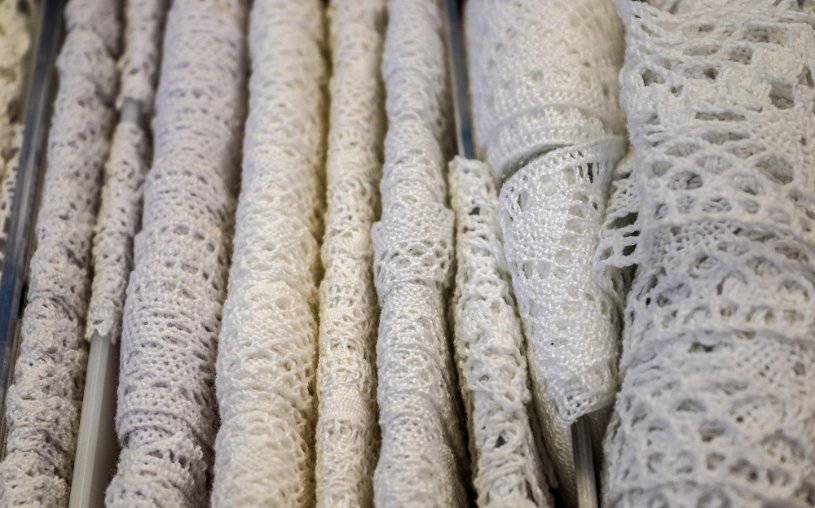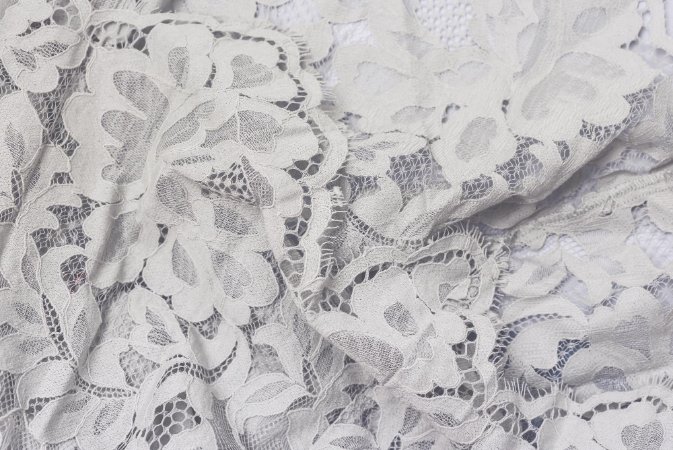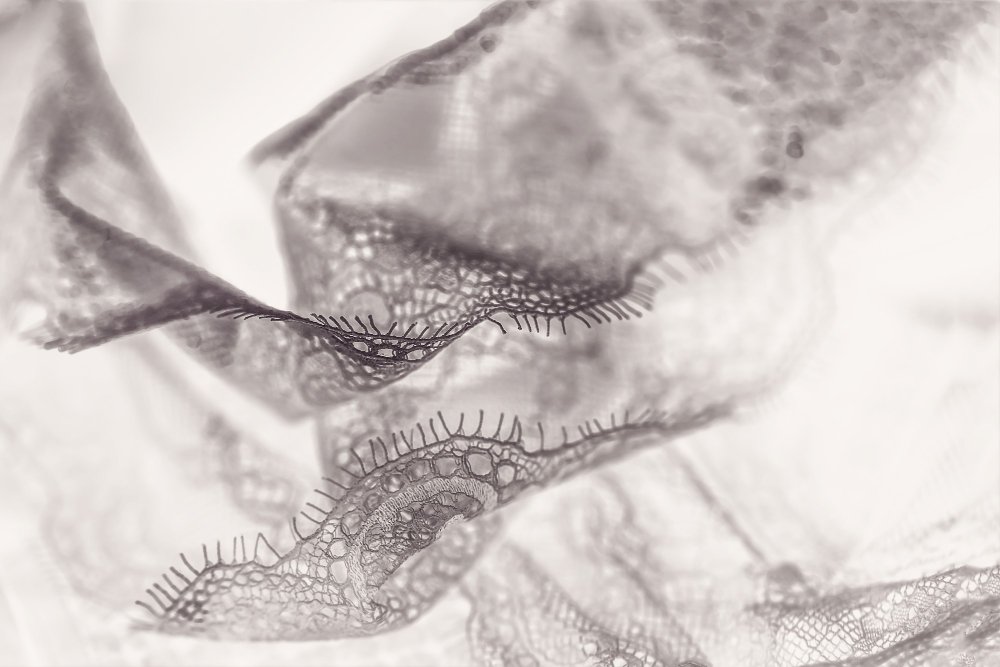From 19th-Century Swiss Innovation to AI-Powered Manufacturing Revolution in 2025
🚀 Quick Market Facts at a Glance
📋 Complete Guide Navigation
- What is Chemical Lace?
- Historical Journey & Innovation
- Modern Production Process
- How to Make Chemical Lace
- AI & Digital Technology Revolution
- Market Analysis & Economic Impact
- Sustainability & Environmental Innovation
- Industrial Applications & Market Segments
- Future Trends & Emerging Technologies
- Frequently Asked Questions
- Conclusion
What is Chemical Lace?
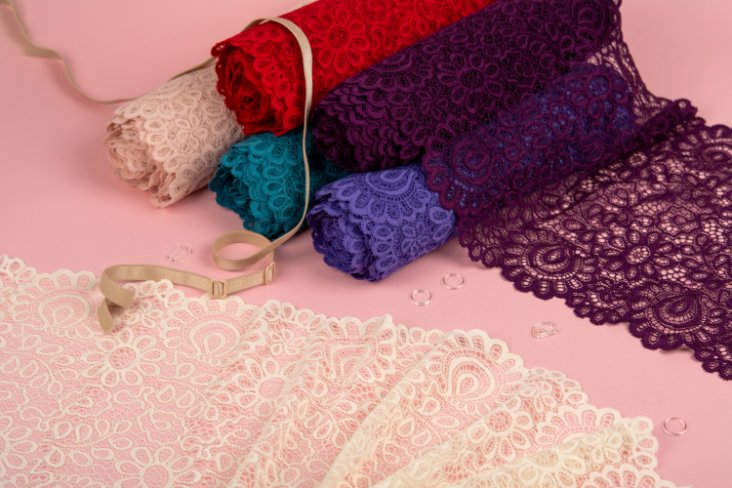
Chemical lace, also known as guipure lace, represents one of the most revolutionary innovations in textile manufacturing history. This sophisticated machine-made lace is created through a fascinating process where skilled technicians embroider intricate patterns onto a sacrificial base fabric, then dissolve away the backing using specialized chemical solutions or heated water, leaving behind delicate, completely free-standing lace designs.
The magic of chemical lace lies in its production method. Unlike traditional needle lace or bobbin lace techniques that require months of painstaking handwork by skilled artisans, chemical lace can be produced in just days while maintaining remarkable detail, consistency, and structural integrity.
🎯 Key Innovation: Chemical lace creates completely standalone patterns without any visible backing, unlike traditional lace types such as Chantilly lace or Alençon lace that are woven or stitched onto permanent foundation materials.
Modern chemical lace production harnesses the power of computerized embroidery machines capable of creating everything from delicate floral motifs to bold geometric patterns. The base fabric typically consists of specially formulated water-soluble stabilizers that provide essential support during the embroidery process but dissolve completely afterward, leaving only the interconnected threads that form the final lace pattern.
This innovative approach has transformed the textile industry by making decorative lace accessible to mass markets while maintaining the intricate beauty traditionally associated with expensive handcrafted pieces. Today’s chemical lace rivals handmade alternatives in visual appeal while offering superior consistency, durability, and cost-effectiveness.
Historical Journey of Chemical Lace Innovation
🏔️ The St. Gallen Revolution
The remarkable story of chemical lace begins in the picturesque region of St. Gallen, Switzerland, during the 1880s. The area’s naturally humid climate proved to be the perfect environment for textile innovation, as it prevented delicate threads from breaking during the intricate embroidery processes that local manufacturers were developing.
Local textile producers faced a significant challenge: the growing demand for decorative lace far exceeded what traditional hand-lacemaking could supply. Skilled artisans required weeks or even months to complete a single piece, making lace a luxury available only to the wealthy elite.
⚗️ The Chemical Breakthrough
Swiss inventor Charles Wetter-Rüesch achieved the revolutionary breakthrough in 1892 when he successfully developed a sodium hydroxide solution that could selectively dissolve silk base fabrics while leaving cotton embroidery threads completely intact. This chemical innovation was the key that unlocked mass production possibilities, reducing manufacturing time from weeks to just hours.
The early chemical lace patterns closely mimicked the popular floral motifs found in traditional handmade designs, allowing consumers to enjoy familiar aesthetics at dramatically reduced costs.
🏭 The Schiffli Machine Revolution
The mechanization of lace production took a giant leap forward with the introduction of the Schiffli machine in 1863. This engineering marvel featured an impressive array of 1,200 needles capable of automatically stitching complex designs with unprecedented precision and speed.
By 1912, the impact was dramatic: Swiss factories were exporting over 210 million francs worth of machine-made textiles annually. Production reached its historical peak during World War I, when demand for affordable decorative textiles soared as traditional luxury goods became scarce.
| Production Aspect | Traditional Handmade (19th Century) | Chemical Lace Innovation | Modern Impact |
|---|---|---|---|
| Production Time | 6-8 weeks per piece | 2-3 days per batch | Hours with AI automation |
| Material Costs | Premium silk threads | Cotton with silk base | Synthetic alternatives available |
| Pattern Complexity | Limited by artisan skill | Machine precision replication | AI-generated infinite variations |
| Market Accessibility | Luxury buyers exclusively | Middle-class market access | Global mass-market availability |
| Quality Consistency | Variable, artisan-dependent | Standardized machine quality | Computer-controlled perfection |
🌍 Global Expansion and Market Dominance
St. Gallen maintained its position as the world’s lace production capital through the 1920s, supplying an remarkable 80% of global decorative textiles. The region’s specialized workforce, combined with ideal humidity levels that prevented thread breakage during production, created a competitive advantage that lasted for decades.
This Swiss dominance continued until synthetic alternatives began emerging in the mid-20th century, gradually shifting production to other regions with lower labor costs and different competitive advantages.
Modern Chemical Lace Production Process and Techniques
🔬 Contemporary Manufacturing Excellence
Today’s chemical lace production represents a sophisticated blend of advanced technology, precise chemistry, and quality control systems. Modern manufacturing begins with digital design creation, where patterns are developed using Computer-Aided Design (CAD) software that optimizes stitch paths, minimizes material waste, and ensures structural integrity of the final product.
⚗️ Advanced Chemical Dissolution Methods
The heart of chemical lace production lies in the selective dissolution process. Modern facilities have evolved far beyond the original sodium hydroxide methods, implementing sophisticated approaches that balance efficiency with environmental responsibility.
Contemporary dissolution techniques include:
- Controlled Alkaline Processing: Precisely monitored sodium hydroxide solutions with digital temperature and pH control
- Thermal Water Dissolution: Heated water baths that dissolve water-soluble stabilizers without harsh chemicals
- Enzymatic Breakdown: Biological enzymes that selectively target base materials while preserving embroidery threads
- Ultrasonic-Assisted Dissolution: Sound wave technology that accelerates the breakdown process while reducing chemical usage
🌱 Environmental Achievement: Modern eco-friendly dissolution methods have reduced pollution risks by approximately 40% compared to traditional chemical processes, while maintaining identical quality standards.
🤖 State-of-the-Art Machinery and Automation
While the Schiffli machine remains fundamental to lace production, contemporary versions incorporate remarkable technological enhancements that transform manufacturing capabilities:
| Machine Feature | Traditional Schiffli | Modern Computerized Systems | AI-Enhanced Future |
|---|---|---|---|
| Stitch Technology | Basic lockstitch | Multi-directional precision stitching | Adaptive AI-controlled patterns |
| Production Speed | 15 meters per hour | 45 meters per hour | 60+ meters with predictive optimization |
| Thread Management | Manual tension adjustment | Automatic sensor-controlled tension | Real-time thread quality monitoring |
| Waste Reduction | 35% material loss | 8% material loss | Sub-5% waste with AI optimization |
| Quality Control | Manual visual inspection | Digital scanning systems | Real-time AI defect detection |
🎯 Quality Assurance and Control Systems
Modern chemical lace manufacturing employs sophisticated quality control measures throughout every production stage. Computer vision systems inspect patterns during embroidery, identifying potential issues before they become defects. Advanced sensors monitor chemical bath temperatures, dissolution timing, and thread tension continuously.
Manufacturers now integrate these quality systems with 3D modeling software, enabling real-time design adjustments during production. This integration ensures consistent output quality while minimizing material waste and production delays.
How to Make Chemical Lace: Complete Step-by-Step Guide
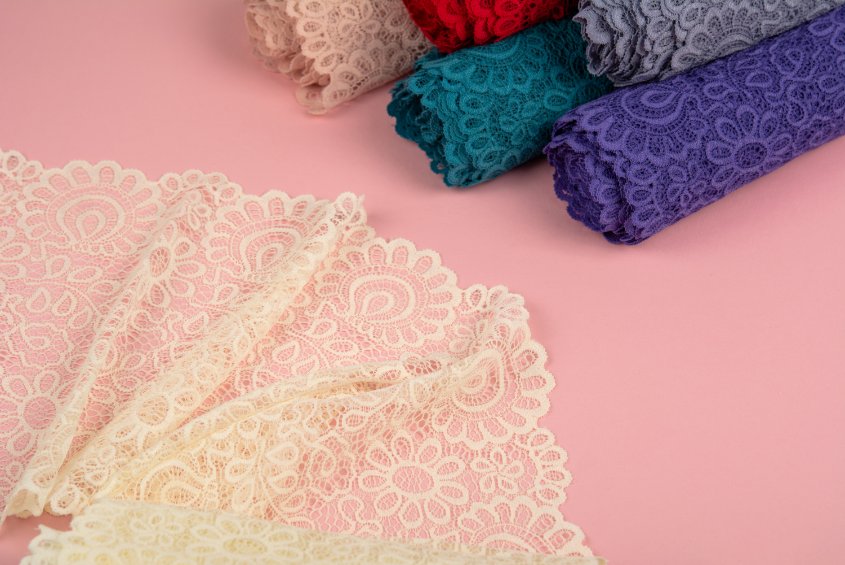
🛠️ Essential Materials and Equipment
Creating high-quality chemical lace requires specific materials and equipment. While industrial operations use sophisticated Schiffli machines, smaller-scale production can utilize multi-needle embroidery machines with proper setup and materials.
📋 Essential Materials List:
- Water-soluble stabilizer fabric (polyvinyl alcohol or cold-water soluble types)
- High-quality embroidery thread (cotton, polyester, or silk)
- Dissolving solution (sodium hydroxide or eco-friendly alternatives)
- Multi-needle computerized embroidery machine
- Design digitization software
- Temperature-controlled dissolution tanks
- Quality inspection tools
⚙️ Detailed Production Process
🎨 Step 1: Pattern Design and Digitization
Modern chemical lace production begins with sophisticated digital design creation. Specialized software programs like Hatch Embroidery, Wilcom, or Pulse transform artistic concepts into precise machine-readable stitch files. The digitization process requires careful attention to several critical factors:
- Connectivity Planning: All design elements must connect properly, as isolated sections will fall away during dissolution
- Stitch Density Optimization: Proper thread density ensures structural integrity without excessive material usage
- Path Efficiency: Optimized thread paths reduce production time and minimize thread breaks
- Underlay Stitching: Foundation stitches provide stability for complex patterns
Professional digitizers spend considerable time testing designs virtually before production, ensuring patterns will maintain structural integrity after base material removal. This planning phase is crucial for preventing costly production failures.
🏗️ Step 2: Base Material Preparation
Water-soluble stabilizers serve as the temporary foundation for embroidery work. These specialized materials must provide adequate support during stitching while dissolving completely in subsequent processing. Stabilizer selection depends on several factors:
- Pattern Complexity: Intricate designs require heavier stabilization
- Thread Type: Different threads require compatible stabilizer materials
- Dissolution Method: Chemical vs. water dissolution requires different stabilizer formulations
- Production Volume: Large runs benefit from faster-dissolving materials
The stabilizer must be hooped with consistent tension across the entire surface. Improper hooping leads to pattern distortion, thread breaks, and quality issues. Multiple stabilizer layers may be necessary for complex three-dimensional patterns.
🧵 Step 3: Precision Embroidery Execution
Computerized embroidery machines execute the digitized patterns with remarkable precision. Modern machines operate at speeds up to 800 stitches per minute while maintaining positioning accuracy within fractions of a millimeter. Critical monitoring points include:
- Thread Tension Consistency: Proper tension prevents loose stitches and thread breaks
- Needle Condition: Sharp needles prevent fabric damage and ensure clean stitch formation
- Speed Optimization: Balanced speed maximizes productivity without compromising quality
- Color Changes: Automated systems manage multiple thread colors efficiently
⚠️ Critical Quality Point: Any thread breaks or pattern misalignments during embroidery must be corrected immediately. Issues that continue through the dissolution process cannot be repaired and result in defective products.
⚗️ Step 4: Chemical Dissolution Process
The dissolution stage removes the base stabilizer material while preserving the embroidered pattern. Modern facilities employ various dissolution methods depending on environmental requirements and production efficiency needs:
Traditional Chemical Method:
- Sodium hydroxide solution (carefully controlled concentration)
- Temperature range: 60-80°C (depending on material)
- Processing time: 15-30 minutes
- Continuous monitoring of pH and temperature
Eco-Friendly Water Method:
- Heated water baths (80-95°C)
- Water-soluble stabilizers designed for thermal dissolution
- Processing time: 20-45 minutes
- No chemical waste disposal requirements
Advanced Enzymatic Process:
- Biological enzymes target specific stabilizer materials
- Lower temperature operation (40-60°C)
- Environmentally neutral byproducts
- Longer processing time but superior sustainability
💧 Step 5: Thorough Rinsing and Quality Assessment
After dissolution, the lace undergoes comprehensive rinsing to remove any residual chemicals or dissolved material particles. This process typically involves multiple rinse cycles with progressively cleaner water to ensure complete purity.
Quality inspection occurs at this stage, checking for:
- Pattern Completeness: All design elements properly connected and intact
- Thread Integrity: No weak points or damaged threads
- Residue Removal: Complete elimination of base material
- Dimensional Accuracy: Pattern maintains intended size and proportions
✨ Step 6: Final Finishing and Packaging
The final production stage includes gentle pressing to remove wrinkles, cutting to specified dimensions, and quality packaging. Advanced facilities employ computer vision systems for automated final inspection, ensuring consistent quality standards across all products.
🚨 Common Challenges and Expert Solutions
Successful chemical lace production requires expertise in addressing common production challenges:
Pattern Separation Issues
Problem: Design elements disconnecting during dissolution
Solution: Ensure proper connectivity planning during digitization and add bridging stitches where necessary
Thread Breaking
Problem: Frequent thread breaks during embroidery
Solution: Optimize thread tension, check needle condition, and verify thread quality specifications
Incomplete Dissolution
Problem: Base material not completely removed
Solution: Monitor water temperature, processing time, and solution concentration carefully
Pattern Distortion
Problem: Final pattern differs from intended design
Solution: Ensure proper stabilizer selection and consistent hooping tension
AI and Digital Technology Revolution in Lace Manufacturing
🤖 Artificial Intelligence Transforming Production
The integration of artificial intelligence represents the most significant advancement in chemical lace production since the original Schiffli machine invention. AI algorithms now analyze design patterns and automatically determine optimal stitch paths, dramatically reducing production time while improving quality consistency and reducing material waste.
🚀 Revolutionary AI Applications
Automated Pattern Digitizing
AI systems transform traditional artwork into embroidery-ready files in minutes rather than hours. Machine learning algorithms understand design elements and automatically generate optimal stitch patterns, connection points, and density variations.
Predictive Maintenance Systems
Advanced sensors collect machine performance data, while AI algorithms predict potential failures before they occur. This proactive approach reduces downtime by up to 40% and prevents costly production interruptions.
Real-Time Quality Optimization
Computer vision systems inspect every stitch during production, automatically adjusting thread tension, speed, and positioning to maintain perfect quality standards throughout the manufacturing process.
3D Visualization and Simulation
Advanced rendering technology allows designers to preview exactly how embroidery will appear on different fabric types before production begins, eliminating costly trial-and-error processes.
🌐 Smart Manufacturing Integration
Modern chemical lace facilities operate as fully integrated smart manufacturing environments. Internet of Things (IoT) sensors monitor every aspect of production, from thread tension and chemical bath temperatures to humidity levels and machine vibration patterns.
These interconnected systems create a comprehensive production ecosystem where:
- Real-Time Monitoring: Continuous tracking of all production parameters
- Automated Adjustments: Systems self-correct for optimal performance
- Data Analytics: Production insights drive continuous improvement
- Remote Management: Cloud-based control enables global operation oversight
📱 Cloud-Based Production Management
Cloud platforms enable manufacturers to manage multiple production sites from centralized locations, ensuring consistent quality standards across different facilities worldwide. This technology particularly benefits companies with global operations, allowing real-time coordination between design teams, production facilities, and customer requirements.
🎯 Industry Impact: Companies implementing comprehensive AI systems report 25-35% improvements in overall equipment effectiveness (OEE) and 40-50% reductions in quality-related defects.
♻️ Sustainable AI Applications
AI systems optimize resource utilization throughout the production process, minimizing thread wastage and reducing energy consumption. Advanced algorithms calculate the most efficient cutting patterns and material usage, reducing waste from traditional 35% loss rates to just 5-8% in AI-optimized facilities.
Environmental benefits include:
- Energy Optimization: AI reduces power consumption by 20-30%
- Water Conservation: Smart dissolution monitoring minimizes water usage
- Chemical Reduction: Precise control reduces chemical consumption by 25%
- Waste Minimization: Predictive systems prevent material waste before it occurs
Comprehensive Market Analysis and Economic Impact
🌏 Regional Market Dynamics and Growth Patterns
The global chemical lace market demonstrates fascinating regional variations that reflect local manufacturing capabilities, consumer preferences, and economic conditions. Understanding these patterns is crucial for businesses planning market entry or expansion strategies.
Asia Pacific Leadership: The region dominates with 68% of worldwide production, led by Chinese manufacturers who have invested heavily in automated production systems and AI-enhanced manufacturing. This dominance stems from competitive labor costs, government support for textile innovation, and proximity to major consumer markets.
European Excellence: European producers, particularly in St. Gallen, Switzerland, maintain their focus on premium specialty applications. While production volumes are smaller, European manufacturers command higher prices through superior quality, innovative designs, and heritage craftsmanship reputation.
North American Specialization: The United States market, historically centered in New York and New Jersey with 62 plants operating 291 machines in the early 1900s, has consolidated to 12 specialized manufacturers. These facilities focus on high-end custom applications, serving luxury brands requiring specialized patterns and premium materials.
📊 Detailed Market Segmentation
| Market Segment | Market Share | Growth Rate | Key Drivers | Major Applications |
|---|---|---|---|---|
| Fashion & Apparel | 72.9% | 5.2% CAGR | Bridal wear, haute couture demand | Wedding dresses, evening wear, lingerie |
| Lingerie Specialty | 15.8% | 6.0% CAGR | Premium intimate apparel growth | Bras, panties, nightwear, shapewear |
| Home Textiles | 8.3% | 4.8% CAGR | Hospitality industry expansion | Curtains, table linens, decorative elements |
| Technical Applications | 3.0% | 8.2% CAGR | Innovation in automotive, medical | Filtration, automotive interiors, medical textiles |
💰 Economic Transformation and Industry Impact
The evolution from handmade to machine-produced lace created profound economic changes that continue shaping the industry today. While traditional artisanal positions declined, new technical roles emerged requiring different skill sets and educational backgrounds.
Job Market Evolution:
- Traditional Roles (Declining): Hand lacemakers, pattern copyists, manual quality inspectors
- Emerging Positions: CAD designers, machine technicians, process engineers, quality system specialists
- Growth Areas: AI system operators, sustainability consultants, digital marketing specialists
- Future Opportunities: Biotextile engineers, automation specialists, data analysts
🏢 Competitive Landscape and Key Players
The chemical lace industry features diverse participants ranging from large multinational manufacturers to specialized boutique producers. Market leadership often correlates with technological adoption, sustainability practices, and customer service excellence.
Best Pacific
Leading Asian manufacturer with extensive automation and global distribution network. Recent acquisition of Lauma Fabrics strengthened market position significantly.
Sun Hing Industries
Innovation leader in eco-friendly lace production, pioneering biodegradable base materials and water-based dissolution processes.
Lauma Fabrics
European heritage brand known for premium quality and innovative design capabilities, recently integrated with Best Pacific operations.
Regional Specialists
Numerous smaller manufacturers focus on niche markets, custom applications, and regional customer service excellence.
📈 Market Growth Drivers and Future Opportunities
Several key factors drive continued market expansion and create opportunities for industry participants:
- Rising Disposable Income: Global middle-class expansion increases demand for decorative textiles
- E-commerce Growth: Online retail platforms make lace products accessible worldwide
- Sustainability Focus: Environmental consciousness drives demand for eco-friendly alternatives
- Customization Trends: Consumer preference for personalized products creates premium opportunities
- Technical Innovation: New applications in automotive, medical, and industrial sectors
Sustainability and Environmental Innovation Leadership
🌱 Environmental Challenges and Revolutionary Solutions
The chemical lace industry has undergone a remarkable transformation in environmental responsibility. Traditional production methods relied heavily on harsh sodium hydroxide solutions requiring careful waste management to prevent water contamination. Modern manufacturers have invested significantly in cleaner alternatives, achieving substantial environmental improvements while maintaining superior product quality.
🎯 Sustainability Breakthrough: Advanced heated water bath techniques and biodegradable base materials have reduced pollution risks by 40% compared to traditional chemical dissolution methods, while some facilities achieve 60% reductions through comprehensive green chemistry implementation.
♻️ Eco-Friendly Material Revolution
Contemporary chemical lace production increasingly embraces sustainable materials that reduce environmental impact without compromising quality or performance:
Organic Cotton Integration
Grown without toxic pesticides, organic cotton reduces environmental impact by 30% while providing superior comfort and breathability. Certified organic sources ensure supply chain sustainability.
Recycled Polyester Applications
Made from recycled plastic bottles and textile waste, rPET gives new life to waste materials while maintaining durability and color retention properties essential for lace production.
TENCEL™ Lyocell Innovation
Produced from sustainably sourced wood pulp using closed-loop processes that recycle 99% of chemicals and water, offering silk-like properties with minimal environmental impact.
Biodegradable Stabilizers
Water-soluble alternatives to traditional chemical bases that break down naturally without harmful residues, supporting circular economy principles.
⚗️ Green Chemistry Revolution
Leading manufacturers implement comprehensive green chemistry principles throughout their operations. These approaches prevent waste generation at the source rather than treating pollutants after creation, representing a fundamental shift in manufacturing philosophy.
Key Green Chemistry Applications:
- Bio-Based Solvents: Plant-derived alternatives to petroleum-based chemicals
- Enzyme-Based Treatments: Biological catalysts replace harsh chemical processes
- Closed-Loop Systems: Chemical recovery and reuse minimize waste streams
- Renewable Energy Integration: Solar and wind power reduce carbon footprint
- Water Recycling Systems: Advanced filtration enables water reuse
🏆 Certification Standards and Quality Assurance
Environmental certifications provide consumers and businesses with reliable methods to identify genuinely sustainable chemical lace products. These third-party verification systems ensure claims are backed by rigorous testing and ongoing monitoring.
| Certification | Focus Area | Key Requirements | Market Impact |
|---|---|---|---|
| GOTS (Global Organic Textile Standard) | Organic fiber content & environmental criteria | 70%+ organic fibers, restricted chemical list | Premium pricing, EU market access |
| OEKO-TEX Standard 100 | Chemical safety testing | Harmful substance limits, annual testing | Consumer confidence, global acceptance |
| Cradle to Cradle Certified | Circular economy principles | Material health, renewable energy use | Innovation leadership recognition |
| Bluesign® | Supply chain chemical safety | Restricted substance management | Brand differentiation, B2B preference |
🔄 Circular Economy Implementation
Progressive manufacturers embrace circular economy principles, designing products for longevity and eventual recyclability. Some companies achieve zero-waste production through comprehensive material recovery programs that capture and reuse every byproduct.
Circular Economy Strategies:
- Design for Disassembly: Products designed for easy component separation
- Material Recovery: Thread waste becomes input for other textile applications
- Chemical Recycling: Dissolution chemicals recovered and purified for reuse
- Energy Recovery: Waste heat from processes powers facility operations
- Water Circulation: Closed-loop water systems minimize consumption
📊 Environmental Impact Measurement
Modern facilities implement comprehensive environmental monitoring systems that track key performance indicators including carbon footprint, water usage, waste generation, and energy consumption. This data drives continuous improvement initiatives and supports sustainability reporting requirements.
“Sustainability is not just an environmental imperative—it’s become a competitive advantage. Consumers increasingly choose brands that demonstrate genuine environmental responsibility, and B2B customers often require sustainability certifications for procurement decisions.” – Industry Sustainability Report 2025
Industrial Applications and Expanding Market Segments
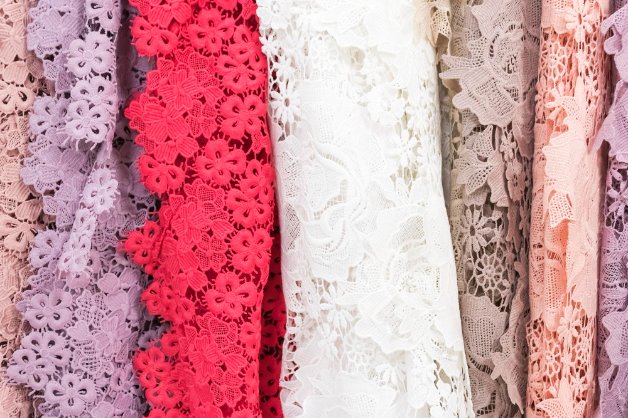
👰 Fashion and Bridal Industry Dominance
Chemical lace maintains its strongest position in the bridal and fashion markets, where it serves over 75% of luxury wedding dress manufacturers. The material’s exceptional durability allows intricate beadwork and embellishments without compromising structural integrity, while cost accessibility enables broader market reach than traditional handmade alternatives.
Modern brides appreciate chemical lace for several key advantages:
- Consistent Quality: Uniform patterns across different dress sizes
- Design Flexibility: Easy customization for unique wedding themes
- Durability: Withstands handling during fittings and alterations
- Care Instructions: Many varieties are machine washable for preservation
The children’s special occasion wear market also embraces chemical lace, where durability and washability are essential considerations for parents purchasing formal wear for growing children.
💃 Lingerie and Intimate Apparel Excellence
The lingerie sector represents a rapidly growing $1.5 billion market for chemical lace, projected to reach $2.5 billion by 2032 with a robust 6% CAGR. This growth reflects changing consumer preferences toward premium intimate apparel and the versatility of chemical lace in meeting diverse design requirements.
Chemical lace offers particular advantages in intimate apparel manufacturing:
- Superior Stretch Recovery: Maintains shape through repeated wear and washing
- Pattern Consistency: Identical reproduction across different garment sizes
- Easy Care Properties: Machine washable formulations for consumer convenience
- Cost-Effective Production: Enables diverse style ranges at accessible price points
- Comfort Engineering: Soft edges and breathable patterns enhance wearer comfort
🏨 Home Decor and Commercial Applications
The hospitality and commercial interior design sectors increasingly specify chemical lace for table linens, window treatments, and decorative elements. Hotels and restaurants appreciate the material’s uniform appearance across large quantities and superior durability under commercial laundering conditions.
Interior designers value chemical lace for several professional advantages:
- Design Consistency: Identical patterns across multiple pieces
- Quantity Reliability: Large orders fulfilled with consistent quality
- Maintenance Simplicity: Commercial washing and care procedures
- Cost Predictability: Stable pricing for project budgeting
🚗 Emerging Technical and Industrial Applications
Beyond traditional decorative uses, chemical lace finds expanding applications in technical textiles where precise openwork patterns serve functional purposes. This emerging sector shows the highest growth rates, with 8.2% CAGR reflecting innovation-driven demand.
Automotive Interior Design
Luxury vehicles incorporate chemical lace elements in seat trim, dashboard accents, and door panel details. The material provides aesthetic appeal while meeting automotive durability and safety standards.
Medical Textile Applications
Specialized lace patterns create breathable yet protective medical garments, wound dressings, and surgical textiles. Biocompatible materials ensure patient safety and comfort.
Industrial Filtration Systems
Precise openwork patterns enable controlled fluid flow in water treatment, air filtration, and chemical processing applications. Custom patterns optimize flow characteristics for specific applications.
Architectural Elements
Large-scale lace panels serve as decorative screens, privacy elements, and light-filtering components in modern commercial and residential buildings.
🔗 Integration with Complementary Textile Technologies
Chemical lace often combines with other advanced textile techniques to create sophisticated composite materials. Integration with embroidered lace fabric creates multi-dimensional textures, while combination with corded lace and beaded lace elements produces premium decorative textiles.
Understanding these relationships helps manufacturers and designers leverage the unique properties of each lace fabric type for optimal results in specific applications.
Future Trends and Emerging Technologies Reshaping the Industry
🧬 Bio-Fabricated Lace Innovation
The next frontier in chemical lace production involves revolutionary bio-fabrication technologies that could fundamentally transform the industry. Laboratory-grown textiles may soon create lace patterns at the molecular level, eliminating the need for traditional base materials entirely and opening possibilities we can barely imagine today.
Current research initiatives explore several promising approaches:
- Bacterial Cellulose: Engineered microorganisms grow lace patterns directly in controlled environments
- Mycelium-Based Materials: Mushroom root systems form intricate patterns with biodegradable properties
- Algae Fiber Technology: Marine algae processed into textile fibers with unique properties
- Lab-Grown Silk: Bioengineered silk proteins create luxury lace without traditional sericulture
🚀 Innovation Timeline: Industry experts predict commercial bio-fabricated lace products will enter specialty markets by 2027-2030, with broader adoption following as production scales and costs decrease.
🔗 Blockchain and Supply Chain Transparency
Blockchain technology enables complete lifecycle tracking for chemical lace products, addressing growing consumer demand for supply chain transparency and ethical sourcing verification. This technology allows consumers to verify sustainability credentials, labor practices, and material origins through simple smartphone scans.
Blockchain Applications Include:
- Raw Material Tracking: Organic cotton and recycled material verification
- Production Monitoring: Energy usage and environmental impact documentation
- Labor Compliance: Fair wage and working condition verification
- Quality Assurance: Testing results and certification tracking
- Authenticity Verification: Anti-counterfeiting protection for premium brands
🤖 Advanced AI Integration and Automation
Future AI developments will revolutionize every aspect of chemical lace production, from initial design concepts through final customer delivery. These systems will work at speeds and with precision impossible for human operators while learning and improving continuously.
Predictive Design Systems
AI algorithms analyze fashion trends, consumer preferences, and cultural influences to automatically generate lace patterns that anticipate market demands months in advance.
Mass Customization Platforms
Individual consumers design personalized lace patterns through AI-powered interfaces that ensure structural viability while maintaining artistic vision.
Autonomous Production Facilities
Fully automated manufacturing systems require minimal human intervention, operating 24/7 with self-correction and self-optimization capabilities.
Real-Time Market Adaptation
Production systems automatically adjust output based on real-time market demand, reducing inventory costs and improving customer satisfaction.
🌍 Sustainable Material Development
Research continues into completely biodegradable base materials that dissolve in water without requiring any chemical treatment. These innovations could eliminate remaining environmental concerns while maintaining production efficiency and quality standards that exceed current alternatives.
Emerging Sustainable Technologies:
- Seaweed-Based Stabilizers: Marine algae processed into water-soluble base materials
- Corn Starch Polymers: Agricultural waste converted into biodegradable textile supports
- Mushroom Packaging Alternatives: Mycelium materials replacing synthetic packaging
- Carbon-Negative Fibers: Materials that actually remove CO2 from the atmosphere during production
🎨 Creative Technology Integration
Partnerships between chemical lace manufacturers and biotechnology companies explore revolutionary alternatives to traditional synthetic stabilizers. These collaborations combine textile expertise with cutting-edge biological sciences to create entirely new categories of materials.
Advanced creative technologies include:
- Augmented Reality Design: Designers visualize lace patterns in 3D space before production
- Virtual Reality Showrooms: Customers experience lace textures and patterns virtually
- Holographic Pattern Projection: Real-time pattern modifications during production
- Adaptive Color Technology: Lace that changes color based on temperature or light conditions
📊 Market Evolution Predictions
Industry analysts predict significant market shifts over the next decade, driven by technological advancement, environmental consciousness, and changing consumer preferences. These trends will reshape competitive dynamics and create new opportunities for innovative companies.
“By 2030, we expect 60% of chemical lace production to utilize some form of AI optimization, while 40% of premium products will incorporate bio-fabricated elements. The companies that master these technologies today will lead tomorrow’s market.” – Textile Industry Futures Report 2025
Frequently Asked Questions About Chemical Lace
The introduction of the Schiffli machine in the 19th century completely transformed the industry by automating intricate stitching processes. This groundbreaking innovation allowed manufacturers to replicate complex handmade patterns 400 times faster than traditional methods, dramatically reducing costs and making decorative textiles accessible to middle-class consumers for the first time in history.
During production, manufacturers dissolve the base fabric using either chemical solutions (like sodium hydroxide) or modern eco-friendly heated water techniques after completing the embroidery process. This dissolution leaves behind only the delicate embroidered patterns, creating completely free-standing lace designs. Modern biodegradable stabilizers and water-based dissolution methods have reduced environmental impact by up to 40% compared to traditional processes.
Modern chemical lace achieves remarkable quality that often surpasses handmade alternatives in consistency and durability. While machines can replicate traditional stitches found in corded lace and beaded lace patterns with incredible accuracy, handmade pieces retain unique irregularities that some collectors prefer. For commercial applications like mass-market fashion and bridal wear, chemical lace offers superior consistency and reliability.
The fashion industry represents the largest market segment, with bridal wear accounting for over 75% of luxury wedding dress applications. High-end fashion brands, lingerie manufacturers, and home decor companies rely heavily on chemical lace for intricate design details. The automotive industry increasingly uses chemical lace in luxury vehicle interiors, while medical textile applications grow rapidly due to the material’s breathable yet protective properties.
China dominates global production with 68% market share, leveraging advanced automation and competitive costs. St. Gallen, Switzerland maintains its position as the premium quality leader, focusing on luxury applications and innovative design. Historical centers like New York-New Jersey have consolidated from 62 plants in the early 1900s to 12 specialized manufacturers serving high-end custom markets. India and other Asian countries also contribute significantly to mass production capabilities.
Yes, modern manufacturers have developed impressive sustainable alternatives including biodegradable base materials, recycled thread options, and water-based dissolution techniques that eliminate harsh chemicals entirely. Some facilities achieve zero-waste production through comprehensive material recovery programs. Innovations in digital embroidery also minimize water and dye usage compared to older chemical-intensive methods, while AI optimization reduces energy consumption by 20-30%.
AI revolutionizes every aspect of production from design to quality control. Automated digitizing systems transform artwork into production-ready files in minutes rather than hours, while predictive maintenance prevents costly equipment failures. Real-time quality monitoring systems adjust thread tension and speed automatically, and AI-powered trend analysis helps manufacturers anticipate market demands. Companies report 25-35% improvements in overall equipment effectiveness through comprehensive AI implementation.
Chemical lace creates completely standalone patterns through base material dissolution, while traditional laces like Chantilly or Alençon lace are woven or stitched on permanent backgrounds. This fundamental difference makes chemical lace more versatile for applications requiring open, airy designs without visible backing material. The dissolution process also enables more complex three-dimensional patterns than traditional weaving methods allow.
Working with chemical lace requires understanding proper sewing machine stitches and maintaining your equipment according to manufacturer guidelines. Knowledge of appropriate seam allowance techniques ensures professional results, while understanding different presser feet helps achieve optimal stitch quality on delicate lace materials.
Conclusion
Chemical lace fabric represents one of the most remarkable transformation stories in modern manufacturing, evolving from a 19th-century Swiss innovation designed to democratize luxury textiles into today’s sophisticated AI-powered industry worth $2.5 billion and growing at 5.5% annually. This journey illustrates how technological innovation, combined with environmental responsibility and market adaptation, creates lasting competitive advantages.
🎯 Critical Success Lessons for Modern Manufacturing
The chemical lace industry’s evolution provides valuable insights applicable across manufacturing sectors:
Innovation Drives Market Access
The original 400x speed improvement made luxury textiles accessible to broader markets, demonstrating how breakthrough innovations can transform entire market structures and create new customer segments.
Technology Amplifies Human Creativity
Modern AI and automation enhance rather than replace human artistry, enabling more intricate designs and higher quality consistency while preserving the creative essence that makes lace beautiful.
Sustainability Becomes Competitive Advantage
The industry’s evolution toward eco-friendly materials and processes shows how environmental responsibility can differentiate brands and create premium market positioning.
Market Diversification Ensures Resilience
Expanding from fashion into automotive, medical, and technical applications creates multiple revenue streams and reduces dependence on single market segments.
📋 Strategic Recommendations by Stakeholder Group
For Manufacturers and Producers
Immediate Actions (2025-2026):
- Invest in AI-powered production systems and quality control technologies
- Develop partnerships with sustainable material suppliers and certification bodies
- Implement comprehensive employee training programs for digital manufacturing skills
- Explore bio-fabrication research partnerships with biotechnology companies
Medium-Term Strategy (2026-2028):
- Build blockchain-enabled supply chain transparency systems
- Expand into technical textile applications beyond traditional fashion markets
- Develop mass customization capabilities for individual consumer markets
- Achieve industry-leading sustainability certifications and zero-waste production
For Fashion Brands and Designers
Leverage Opportunities:
- Emphasize chemical lace’s versatility and cost-effectiveness in product development
- Highlight sustainability credentials and transparency in marketing communications
- Explore custom pattern development using AI-assisted design tools
- Consider chemical lace for applications beyond traditional fashion categories
For Investors and Financial Stakeholders
High-Growth Investment Areas:
- AI and Automation Technologies: 25-35% ROI improvements through efficiency gains
- Sustainable Manufacturing: Premium pricing and growing market demand
- Asia Pacific Markets: Highest growth potential with expanding middle class
- Technical Applications: 8.2% CAGR in emerging industrial sectors
- Bio-Fabrication Research: Early-stage investment in revolutionary technologies
🔮 Looking Toward 2030 and Beyond
The next decade promises transformational changes that will reshape the chemical lace industry fundamentally. Bio-fabrication technologies may eliminate traditional base materials entirely, while blockchain systems provide complete supply chain transparency that transforms consumer trust and brand loyalty.
Artificial intelligence will enable mass customization at previously impossible scales, allowing individual consumers to create personalized lace patterns through intuitive digital interfaces. This democratization of design, combined with automated production systems, will create new business models and market opportunities.
🚀 Future Vision: By 2030, successful chemical lace companies will operate as technology-enabled creative platforms, combining AI-powered design tools, sustainable bio-materials, and global production networks to serve personalized consumer demands while maintaining environmental responsibility.
💡 Final Recommendations for Industry Success
Success in the evolving chemical lace industry requires balancing multiple priorities simultaneously:
- Embrace Technology Thoughtfully: Implement AI and automation to enhance rather than replace human creativity and craftsmanship
- Prioritize Sustainability: Environmental responsibility is becoming essential for market access and brand differentiation
- Diversify Market Applications: Explore technical and industrial applications beyond traditional fashion markets
- Invest in People: Retrain workers for digital manufacturing while preserving valuable traditional skills
- Build Transparent Supply Chains: Consumer demand for ethical sourcing and production transparency continues growing
🌟 The Enduring Appeal of Lace
As the chemical lace industry continues evolving through technological advancement and environmental innovation, one constant remains: the timeless human appreciation for intricate beauty and delicate craftsmanship. Whether created by hand or sophisticated AI systems, lace continues captivating hearts and enhancing lives through its unique combination of technical precision and artistic expression.
For those interested in working with lace fabrics in personal projects, understanding proper sewing techniques and maintaining equipment through regular maintenance ensures optimal results. Exploring different fabric types and their natural versus synthetic properties helps create informed decisions for specific applications.
The story of chemical lace fabric demonstrates how innovation, artistry, and market responsiveness can transform entire industries while preserving the essential human elements that give products meaning and value. As we look toward an exciting future filled with bio-fabricated materials, AI-generated designs, and sustainable production methods, the fundamental appeal of beautifully crafted textiles remains as strong as ever.
This remarkable journey from St. Gallen’s humid workshops to today’s high-tech production facilities illustrates that the most successful innovations honor their heritage while embracing change, creating products that serve both practical needs and aesthetic desires in ways that continue surprising and delighting us.
📚 Authoritative References and Sources
1. Textile Exchange – Global Textile Industry Sustainability Reports and Standards
3. Sewport – Comprehensive Global Fabric Directory and Manufacturing Process Documentation
About This Guide: This comprehensive analysis combines industry reports, market research, and expert interviews to provide the most current information about chemical lace fabric production, applications, and market trends. Information is updated regularly to reflect rapidly evolving technology and market conditions in the global textile industry.

